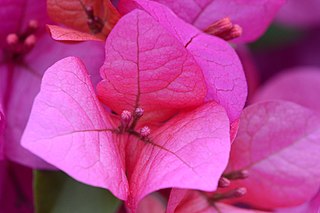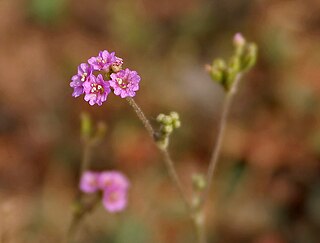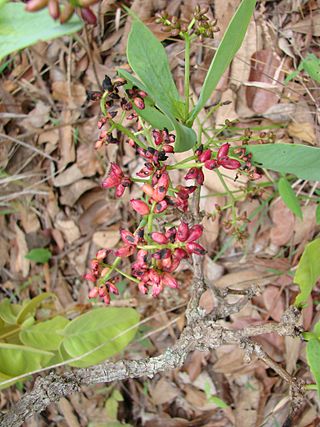
Mirabilis is a genus of plants in the family Nyctaginaceae known as the four-o'clocks or umbrellaworts. The best known species may be Mirabilis jalapa, the plant most commonly called four o'clock.

Bougainvillea is a genus of thorny ornamental vines, bushes, and trees belonging to the four o' clock family, Nyctaginaceae. They are native to Brazil, Bolivia, Paraguay, Peru, and Argentina. There are between 4 and 22 species in the genus. The inflorescence consists of large colourful sepal-like bracts which surround three simple waxy flowers, gaining popularity for the plant as an ornamental. The plant is named after explorer Louis Antoine de Bougainville (1729-1811), after it was documented on one of his expeditions.

Chlorophytum (,), sometimes colloquially referred to as the spider plants, is a genus of almost 200 species of evergreen perennial flowering plants in the century plant subfamily within the asparagus family. The plants are native to the tropical and subtropical regions of Africa, Australia, and Asia.

Indigofera is a large genus of over 750 species of flowering plants belonging to the pea family Fabaceae. They are widely distributed throughout the tropical and subtropical regions of the world.

Fagonia is a genus of wild, flowering plants in the caltrop family, Zygophyllaceae, having about 34 species. The latest reorganization of the genus took place in 2018 when systematists Christenhusz & Byng, Royal Botanical Gardens, Kew (UK) included Fagonia spp.. along with several other Zygophyllum genera, into a new genus named "Zygophyllum L." Species occurring in the US are commonly referred to as fagonbushes. The distribution of the genus includes parts of Africa, the Mediterranean Basin, the Mid-East, India, and parts of North & South America. Fagonia species have been used ethnobotanically by traditional practitioners under Ayurvedic and other TM healing regimes for many maladies. Species occur in deserts, dry washes, ditches and on rocky outcrops, including at altitude.

Commiphora is the most species-rich genus of flowering plants in the frankincense and myrrh family, Burseraceae. The genus contains approximately 190 species of shrubs and trees, which are distributed throughout the (sub-) tropical regions of Africa, the western Indian Ocean islands, the Arabian Peninsula, India, and South America. The genus is drought-tolerant and common throughout the xerophytic scrub, seasonally dry tropical forests, and woodlands of these regions.

Pisonia is a genus of flowering plants in the four o'clock flower family, Nyctaginaceae. It was named for Dutch physician and naturalist Willem Piso (1611–1678). Certain species in this genus are known as catchbirdtrees, birdcatcher trees or birdlime trees because they catch birds. The sticky seeds are postulated to be an adaptation of some island species that ensures the dispersal of seeds between islands by attaching them to birds, and also allows the enriching of coralline sands. These island species include P. brunoniana of Australasia and Polynesia and P. umbellifera, which is widespread in the tropical Indo-Pacific region.

Boerhavia is a genus of over 100 species in the Nyctaginaceae family. The genus was named for Herman Boerhaave, a Dutch botanist, and the genus name is frequently misspelled "Boerhaavia". Common names include spiderlings and hogweeds.
Ormocarpum is a genus of flowering plants in the legume family, Fabaceae. It includes 17 species native to tropical and southern Africa and parts of India, Indochina, Malesia, Papuasia, and the South Pacific. The genus was recently assigned to the informal monophyletic Dalbergia clade of the Dalbergieae.

Melhania is a genus of small shrubs or herbaceous plants. Traditionally included in the family Sterculiaceae, it is included in the expanded Malvaceae in the APG and most subsequent systematics. The genus is named for Mount Melhan in Yemen.

Neea is a genus of plants in family Nyctaginaceae from the Caribbean region, Central and South America. Members of the genus are commonly called Nia, Neea, or saltwood.

Zygophyllum is the type genus of the flowering plant family Zygophyllaceae. The generic name is derived from the Greek words ζυγόν (zygon), meaning "double", and φυλλον (phyllon), meaning "leaf". It refers to the leaves, each of which have two leaflets.

Senegalia is a genus of flowering plants in the family Fabaceae. It belongs to the Mimosoid clade. Until 2005, its species were considered members of Acacia. The genus was considered polyphyletic and required further division, with the genera Parasenegalia and Pseudosenegalia accepted soon after.
Microcharis is a genus of flowering plants. It includes 36 species of herbs and shrublets native to Africa and the Arabian Peninsula. The genus is in tribe Indigofereae of family Fabaceae. Typical habitats include seasonally-dry tropical forest margins, woodland, thicket, wooded grassland, and grassland, often in damp, swampy, or riverine areas, or in shallow soil over rocks.

Crabbea is a genus of flowering plants native to eastern and southern Africa. They are generally low-growing perennial herbs. The five-petaled flowers are surrounded by prickly bracts.
Pisoniella is a monotypic genus of flowering plants belonging to the family Nyctaginaceae. It only contains one known species, Pisoniella arborescens(Lag. & Rodr.) Standl.

















